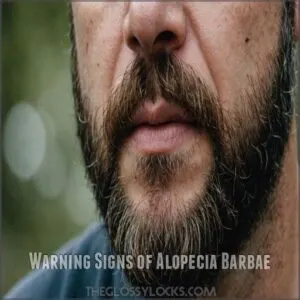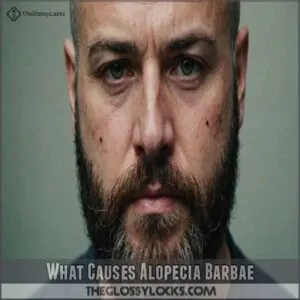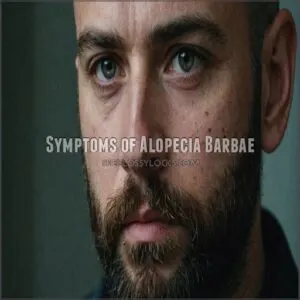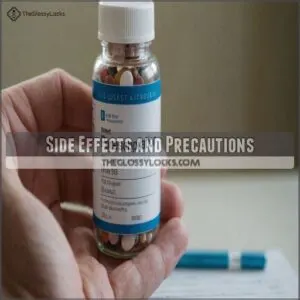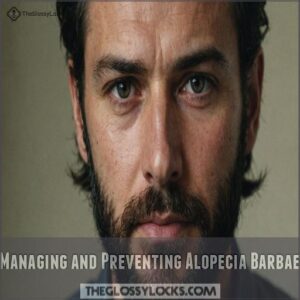This site is supported by our readers. We may earn a commission, at no cost to you, if you purchase through links.
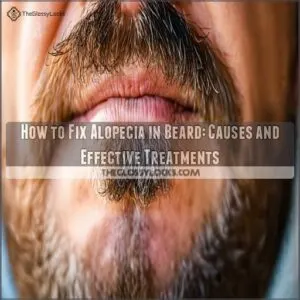 If you’re wondering how to fix alopecia in your beard, several strategies might help.
If you’re wondering how to fix alopecia in your beard, several strategies might help.
First, keep an eye on the area—sometimes hair returns naturally within months.
Topical corticosteroids could be your best friend here, as they reduce inflammation.
Don’t overlook Minoxidil either; it’s notorious for stirring up those follicles.
For a high-tech twist, consider platelet-rich plasma therapy, or if patience isn’t your virtue, a beard transplant might be the bold move.
Always consult a dermatologist for a personalized plan—they can check if genetics or stress is fueling those gaps.
Curious about natural remedies too? We can help!
Table Of Contents
- Key Takeaways
- What is Alopecia Barbae
- Warning Signs of Alopecia Barbae
- What Causes Alopecia Barbae
- Symptoms of Alopecia Barbae
- How to Diagnose Alopecia Barbae
- Treatment Options for Alopecia Barbae
- Minoxidil for Beards and Alopecia Barbae
- Other Treatments for Alopecia Barbae
- Managing and Preventing Alopecia Barbae
- Regrowing Hair and Overcoming Alopecia Barbae
- Frequently Asked Questions (FAQs)
- How do you treat beard alopecia areata?
- What is the remedy for male alopecia?
- What causes beard alopecia?
- Can alopecia cause beard hair loss?
- Can you cure beard alopecia?
- Will my beard grow back after alopecia?
- Is there a way to fix bald spots in a beard?
- Can you regrow hair alopecia?
- Can stress cause alopecia in my beard?
- Is alopecia barbae contagious or hereditary?
- Can diet changes prevent beard hair loss?
- How long does beard hair take to regrow?
- Are there alternative therapies for beard alopecia?
- Conclusion
Key Takeaways
- To support regrowth, introducing lifestyle changes such as scalp massage techniques can increase blood flow and stimulate hair follicles, try exploring natural remedies for thinning hair men. Keep an eye on alopecia patches, as hair might regrow naturally over time, but consider trying topical corticosteroids or Minoxidil to stimulate growth and reduce inflammation.
- Consult a dermatologist to create a personalized treatment plan and explore advanced options like platelet-rich plasma therapy or a beard transplant if needed.
- Manage stress effectively through lifestyle changes like regular exercise and mindfulness practices, as stress can trigger or worsen alopecia barbae.
- Use natural remedies like essential oils and maintain a healthy diet to support overall hair health, complementing medical treatments for better results.
What is Alopecia Barbae
Alopecia barbae is a form of hair loss that targets your beard, often manifesting as small circular bald patches.
It’s caused by your immune system mistakenly attacking hair follicles.
While the precise triggers remain unknown, factors such as stress and genetics may heighten your risk, especially if family members have alopecia or other autoimmune conditions.
Definition and Overview
Alopecia barbae, a facial hair nuisance, strikes when your immune system misfires, attacking hair follicles and causing beard hair loss.
You might spot patchy beard areas, which aren’t fun, but understanding helps.
Here’s the scoop:
- Autoimmune disorder: It’s like friendly fire in hair follicle attacks.
- Patchy beard: Circles of lost hair.
- Symptoms kick in suddenly: One day, you’ve got a smooth spot.
Causes and Risk Factors
Imagine this: you’re noticing small circular patches in your beard, and it’s throwing you for a loop. This could be Alopecia Barbae—an autoimmune condition where stress and genetics tag-team against your hair follicles.
Fortunately, hair regrowth is possible with the right treatment, such as hair growth treatment for alopecia.
Factors like allergies and lifestyle habits might also weigh in.
Embrace understanding the underlying causes as your first step in reclaiming control and mastery over your beard battle.
Symptoms and Diagnosis
Wondering if your beard’s odd patches are more than just a bad grooming day?
Hair loss patterns in alopecia barbae often appear as circular bald spots, with patch size variation and smooth or rough skin texture changes.
You might notice exclamation mark hairs.
Diagnosis usually involves microscope analysis by a dermatologist, checking for beard shedding and autoimmune signs.
Warning Signs of Alopecia Barbae
Recognizing early signs of beard hair loss is key to timely treatment. Sudden hair loss, specifically in your beard, shouldn’t be ignored. Keep an eye out for these warning signs, which might be influenced by factors such as hormonal fluctuations affecting hair texture learn more about hair texture.
- A patchy beard, appearing almost overnight.
- Intense itching in the affected area, sometimes preceding hair loss.
- Noticeable redness or inflammation around thinning patches.
- White edges surrounding bald spots; these are often a telltale sign. If you see these symptoms, consult a dermatologist for a proper hair loss diagnosis and to discuss treatment options for alopecia barbae, or beard alopecia areata. Early intervention can make a real difference.
What Causes Alopecia Barbae
You might wonder why those pesky bald patches appeared in your beard, and it often boils down to your immune system mistakenly attacking the hair follicles, a condition called alopecia barbae.
While the exact cause remains elusive, factors such as genetics, family history of autoimmune disorders, and stress can greatly increase your chances of developing this condition.
Autoimmune Disorders
Imagine your beard suddenly playing hide and seek.
Alopecia barbae, a condition where patches of beard hair fall out, is caused by autoimmune disorders like alopecia areata.
Your immune system mistakenly sees hair follicles as foes, triggering bald patches.
Managing flare-ups involves awareness and lifestyle tweaks.
Treatments like corticosteroids help, but support groups and exploring alternative therapies can make a positive impact, guiding you through this patchy journey.
Genetics and Family History
You’re not alone if beard alopecia areata runs in your family.
Genetics and family history play a significant role, as alopecia areata links to autoimmune diseases like type 1 diabetes or lupus.
In fact, steroid injections, such as triamcinolone acetonide treatments, have been shown to be effective in treating alopecia areata.
If close relatives have experienced autoimmune conditions, your genetic predisposition increases the likelihood.
Understanding these inheritance patterns equips you better to manage the unpredictability of alopecia barbae.
Physical and Psychological Stress
Stress plays a significant role in alopecia barbae, potentially triggering or worsening beard hair loss.
Consider these steps to tackle stress:
- Identify Stress Triggers: Keep a journal of stressful events.
- Use Stress Management Techniques: Try deep breathing.
- Explore Coping Mechanisms: Exercise regularly.
- Build Support Systems: Connect with friends or therapists.
These can aid in hair regrowth and treatment.
Symptoms of Alopecia Barbae
You might notice alopecia barbae when small, circular bald patches appear in your beard, often accompanied by itching or mild pain in the affected area.
These patches can grow, with telltale "exclamation mark" hairs, and indicate an autoimmune reaction targeting hair follicles.
Circular Bald Patches
Spotting circular bald patches in your beard can be unsettling.
These patches, often the size of a quarter, might seem harmless but are classic signs of alopecia barbae, a form of alopecia areata.
The patch’s texture might be smooth, differing in color from the surrounding beard.
Consider options like steroid injections or a hair transplant to address patch size and encourage regrowth.
Itching and Pain
Besides those annoying bald patches, you might also experience itching and pain.
This discomfort often precedes hair loss, possibly due to scalp inflammation.
Pain relief can come from over-the-counter options or, for severe cases, steroid cream or intralesional steroid therapy might be considered.
Managing these symptoms is key to overall alopecia areata management.
Home remedies, like gentle cleansing, can help.
Understanding the causes—like autoimmune triggers—empowers you to take control.
Exclamation Mark Hairs
If you’re experiencing hair loss in your beard, it’s essential to understand the underlying causes, such as genetics and hormonal factors that influence beard growth patterns. Imagine spotting tiny hairs that look like exclamation marks—thin at the root, thicker at the tip—around your beard’s bald patches.
These unique hairs are a telltale sign of alopecia barbae, a condition where your immune system targets hair follicles.
For effective management, consider exploring alopecia beard treatment options from reputable sources, such as Restovie alopecia solutions.
Alopecia areata is an autoimmune condition where the immune system attacks hair follicles, often causing sudden loss of hair patches. While they might add a dose of intrigue, they’re part of the hair loss patterns linked with alopecia areata.
How to Diagnose Alopecia Barbae
Diagnosing alopecia barbae involves more than just spotting bald patches, so visit a dermatologist who can examine your beard and take hair samples for analysis.
They might also suggest a skin biopsy or blood tests to check for underlying conditions, ensuring you get the right treatment plan.
Medical Examination
You’ve felt the itch and noticed that circular patch, but what’s next? Visiting a dermatologist is your ace in the hole for unraveling Alopecia Barbae. They’ll likely:
- Skin Biopsy: Assess underlying conditions.
- Blood Test: Rule out other autoimmune disorders.
- Consultation with a Hair Loss Specialist: Discuss hair restoration options for peace of mind.
Hair Samples and Microscope Analysis
To diagnose alopecia barbae, a close look at hair samples under a microscope is key.
By preparing the samples carefully, experts can use different microscope types for detailed hair analysis.
This process helps identify signs of non-scarring hair loss.
These lab techniques, rooted in trichology, offer insights into why your beard might be misbehaving, guiding effective treatment paths.
Skin Biopsy and Blood Tests
Wondering how to nail down a diagnosis for alopecia barbae? You’ll need to think about a skin biopsy and blood tests.
While biopsies can seem scary, they’re essential for pinpointing biopsies risks and autoimmune disease markers.
Blood tests help check for dihydrotestosterone (DHT) levels and other test accuracy factors.
With accurate test results, you can better understand what’s at play.
Treatment Options for Alopecia Barbae
To tackle alopecia barbae, a variety of treatment options are available, including the use of corticosteroids and minoxidil to promote hair growth.
You can also explore home remedies like essential oils and lifestyle changes such as stress reduction, which might help manage the condition.
Medications and Steroids
After diagnosis, your doctor might suggest medications.
Steroids, like topical corticosteroids or oral prednisone, can help reduce inflammation and promote hair regrowth.
However, long-term use carries side effects.
Other options include minoxidil, diphencyprone (DPCP), or JAK inhibitors.
Each medication has its own effectiveness and potential side effects, so discuss the best approach with your dermatologist.
They’ll help you weigh the pros and cons to find what works best for you.
Home Remedies and Natural Options
Switching gears from medications, let’s tackle natural remedies for Alopecia Barbae.
Boost your beard’s health using essential oils, supplements, and a stress-relief routine.
Consider these approachable options:
- Coconut oil massages for silky smooth beard hair.
- Biotin supplements for potential thickening.
- Lavender oil applications to relax follicles.
- Stress-control techniques to keep hair intact.
- Wheatgrass smoothies for a nutrient-packed diet.
Lifestyle Changes and Self-Care
You’ve tried home remedies, so consider lifestyle changes for Alopecia Barbae.
Stress management, diet, and mindfulness all play a role.
If you’re looking for specific products to help with beard hair loss, check out products for beard hair loss.
Prioritizing sleep hygiene and exercise can boost beard growth.
Here’s a quick guide:
| Aspect | Key Focus |
|---|---|
| Stress Management | Meditation and relaxation |
| Diet & Nutrition | Balanced, rich in protein |
| Sleep Hygiene | Consistent sleep schedule |
| Exercise Routine | Regular physical activity |
| Mindfulness Practices | Yoga and breathing exercises |
Minoxidil for Beards and Alopecia Barbae
If you’re dealing with alopecia barbae, trying minoxidil on your beard might help, as it’s known to stimulate hair growth and improve beard fullness.
However, be cautious of potential side effects like skin irritation, and consult with a healthcare professional to make sure it’s the right choice for you.
Effectiveness and Application
Minoxidil’s magic in your beard growth journey is no fairy tale. You’ll witness the power of this topical solution if used right—apply twice daily and watch for progress. While topical solutions are great, you might also consider boosting your beard growth potential with a beard growth vitamin regimen to support hair health from within. Understanding that alopecia areata is an autoimmune disease that causes round, smooth bald patches in beard, tackling this condition requires patience and effective treatments. Whether tackling alopecia barbae or yearning for fuller facial hair, Minoxidil could be your secret weapon.
- Minoxidil application: Use consistently for best results
- Results timeline: Noticeable changes within 4-6 months
- Product choice: Opt for well-known brands
- Dosage: Stick to recommended amounts
- Micro-pigmentation tattooing: Consider as an alternative therapy
Stay committed, and good things might sprout!
Side Effects and Precautions
Diving into minoxidil, you might wonder about side effects and how they could tangle with your day-to-day.
Well, some folks experience scalp irritation or unwanted hair growth in odd places—imagine a patchy Picasso painting on your cheek!
It’s key to manage stress effectively, as it can trigger or worsen alopecia barbae by affecting hair follicle health.
Hair regrowth risks are real, especially if you’re juggling medications; interactions mightn’t play nice.
Before jumping into beard transplants or flashy treatments like semi-permanent tattooing, consider safe options like anthralin or calcipotriene.
Keep your stress in check, and remember, managing Alopecia Barbae means balancing treatments and keeping an eye on how your body reacts.
Other Treatments for Alopecia Barbae
When dealing with alopecia barbae, exploring other treatments like hair loss shampoos and biotin supplements can complement traditional methods.
For those considering more permanent solutions, options such as beard transplants offer a path to regrowth, though it involves surgical intervention.
Hair Loss Shampoo and Biotin Supplements
Considering shampoos for alopecia barbae? Look for thickening shampoos with gentle, nourishing ingredients. Avoid harsh sulfates and silicones.
Biotin supplements might help, but remember, the recommended Biotin dosage varies; consult your doctor. Be wary of hair growth myths; results vary greatly.
While biotin is often touted, consider supplement alternatives like zinc or saw palmetto. Always be aware of potential side effects and discuss any new supplements with your doctor.
Remember, consistent self-care is key to managing alopecia areata and other alopecia causes impacting men’s health. A healthy lifestyle contributes greatly to hair growth.
Beard Transplant and Surgical Options
Facing Alopecia Barbae and considering a beard transplant? This surgical option can boost your chin’s hairline, with follicles reallocated to bald patches, offering a natural-looking beard.
The cost may vary, often influenced by the number of grafts you need, but can range from $2,400 to $11,250, depending on the surgeon’s expertise and grafts required, as seen in beard transplant pricing.
Let’s talk recovery—it might require a few days of downtime, but success rates are generally high.
Alternatives include topical treatments and lifestyle changes.
Consulting a dermatologist can help weigh options and make sure your choice fits your needs.
Managing and Preventing Alopecia Barbae
To manage and prevent alopecia barbae, focus on reducing stress and maintaining a healthy lifestyle, as these factors can help strengthen your beard’s resilience.
Avoid harsh chemicals and products that may irritate your skin, as this could exacerbate hair loss in the affected areas.
Reducing Stress and Anxiety
Let’s shift gears to stress and anxiety, significant players in managing Alopecia Barbae.
Try these strategies to ease tension:
- Mindfulness and Deep Breathing: Practice regularly to calm your mind.
- Exercise: Engage in physical activity for mood enhancement.
- Therapy and Support Groups: Join groups for emotional backing and coping strategies.
Reducing stress mightn’t fix everything, but it helps!
Maintaining a Healthy Lifestyle
A healthy lifestyle is your ally in managing alopecia barbae.
Focus on stress management and incorporate a balanced diet rich in vitamins to support hair care.
Regular exercise routines boost circulation and overall wellbeing, while maintaining sleep hygiene aids recovery.
These steps, along with understanding factors like UV therapy, can make you feel more empowered when facing alopecia areata.
Avoiding Harsh Chemicals and Products
Aim for a beard care routine that avoids harsh chemicals and products, protecting your skin and hair from further damage caused by alopecia Barbae.
Choose chemical-free options and check product ingredients carefully.
Natural alternatives, like using coconut oil instead of synthetic moisturizers, can help manage alopecia areata.
Pay attention to potential allergens, which might irritate your skin and exacerbate hair loss issues.
Regrowing Hair and Overcoming Alopecia Barbae
To effectively tackle alopecia barbae and promote hair regrowth, you can explore a combination of natural remedies, medical treatments, and supportive therapies.
Understanding these approaches helps restore your beard and also builds emotional resilience, allowing you to confidently face this challenge.
Natural Remedies and Supplements
While scientific evidence is limited, some find relief through natural approaches.
Consider incorporating herbal remedies like rosemary oil, known for its potential hair-growth benefits.
Diet changes focusing on nutrient-rich foods can help address vitamin deficiencies, often linked to hair loss.
Stress management techniques, like meditation, can also support healthy hair growth.
Remember, consistency is key; these remedies often require time to show results.
Medical Treatments and Therapies
Corticosteroids can powerfully tackle alopecia barbae, reducing inflammation and encouraging regrowth. Topical treatments with DPCP may provoke the immune system to restart hair growth. Minoxidil, despite potential side effects, is another option. For severe cases, a hair transplant might be considered.
- Corticosteroids: Suppress inflammation.
- Minoxidil: May promote growth.
- DPCP: Triggers immune response.
Emotional Support and Coping Mechanisms
Having explored medical treatments, let’s not forget emotional well-being.
Joining support groups can feel like a balm, offering a sense of belonging.
Practicing self-care and stress management helps maintain a positive mindset.
Accepting changes with grace takes courage, but focusing on what you can control nurtures resilience, setting the stage for both hair and confidence to flourish.
Frequently Asked Questions (FAQs)
How do you treat beard alopecia areata?
Beard alopecia areata feels like an epic battle, but you can tackle it using treatments like corticosteroids or minoxidil to stimulate growth.
Dermatologists can provide personalized treatments, so consult them for specific advice and reclaim facial freedom.
What is the remedy for male alopecia?
To tackle male alopecia, explore options like minoxidil or finasteride, which can boost hair growth.
A low-level laser therapy might also help.
Seek a dermatologist’s advice for personalized guidance, addressing potential underlying causes and treatment plans.
What causes beard alopecia?
Alopecia barbae, affecting your beard, stems from an autoimmune response attacking hair follicles.
Stress and genetics might play a role.
It’s not contagious, but a dermatologist can help diagnose and manage it.
Can alopecia cause beard hair loss?
Alopecia can definitely cause beard hair loss by triggering small, circular bald patches in the area.
This happens because your immune system mistakenly targets hair follicles, leading to hair falling out unpredictably.
Can you cure beard alopecia?
Beard baldness isn’t easily eradicated, but you can manage it.
While no cure exists for alopecia barbae, treatments like corticosteroids and minoxidil may help, and lifestyle changes can support hair health.
Consult a dermatologist.
Will my beard grow back after alopecia?
After alopecia, your beard might regrow within months, but results vary.
Treatments like corticosteroids or minoxidil can help.
Engaging in self-care and finding a supportive community might ease your journey.
Consult a dermatologist for personalized advice.
Is there a way to fix bald spots in a beard?
Ever wondered if those beard bald spots are fixable?
While no cure exists, treatments like corticosteroids or minoxidil can boost regrowth.
Natural remedies and self-care, like healthy oils and diet, offer additional support.
Consult a dermatologist.
Can you regrow hair alopecia?
Regrowing hair from alopecia can be tricky, but treatments like corticosteroids and minoxidil might help.
Hair can sometimes regrow on its own, so it’s a mix of patience and trying different approaches to encourage growth.
Can stress cause alopecia in my beard?
Yes, stress can trigger alopecia barbae, an autoimmune attack on beard follicles.
It’s not the only cause, but managing stress might help.
Consult a dermatologist for proper diagnosis and treatment options.
Is alopecia barbae contagious or hereditary?
Imagine your genes as a secret baking recipe—sometimes they surprise you.
Alopecia barbae isn’t contagious, but it can run in families.
If your relatives have autoimmune disorders, asthma, or allergies, you might be more likely to get it.
Can diet changes prevent beard hair loss?
Eating a balanced diet might help maintain healthy hair, but it won’t specifically prevent beard hair loss.
Make sure you’re getting enough vitamins like biotin and minerals like zinc to support overall hair health.
How long does beard hair take to regrow?
Beard hair typically regrows in a few months, often taking 3 to 6 months for noticeable growth.
Patience is key.
Factors like your overall health, genetics, and the reason for hair loss can influence this timeline.
Are there alternative therapies for beard alopecia?
Balancing between nature and remedies, you might explore essential oils like rosemary or lavender, known for promoting hair growth.
Acupuncture and stress management techniques, which can complement traditional treatments for managing alopecia barbae, are other options.
Conclusion
A stitch in time saves nine, and addressing alopecia in your beard early can spare you a lot of trouble.
By understanding the causes like autoimmune issues or stress, you can take effective steps such as using medications like Minoxidil or exploring natural remedies.
Consult a dermatologist for a personalized approach to find what suits you best.
With patience and proper care, you can tackle how to fix alopecia in your beard and regain your confidence.


